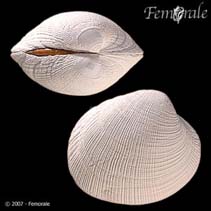Leukoma staminea (Conrad, 1837)
Pacific littleneck| Native range | All suitable habitat | Point map | Year 2050 |

|
| This map was computer-generated and has not yet been reviewed. |
| Leukoma staminea AquaMaps Data sources: GBIF OBIS |
Classification / Names Tên thường gặp | Các synonym ( Các tên trùng) | CoL | ITIS | WoRMS
Bivalvia | Venerida | Veneridae
Environment: milieu / climate zone / Mức độ sâu / distribution range Sinh thái học
; Mức độ sâu 0 - 46 m (Tài liệu tham khảo 95344). Boreal, preferred 8°C (Tài liệu tham khảo 107945); 60°N - 22°N, 166°E - 109°W
Distribution Các nước | Các khu vực của FAO | Các hệ sinh thái | Những lần xuất hiện | Những chỉ dẫn
Pacific Ocean: West to east Bering Sea, Aleutian to Baja California.
Length at first maturity / Bộ gần gũi / Weight / Age
Chín muồi sinh dục: Lm ?, range 2 - 3.5 cm Max length : 7.5 cm SHL con đực/không giới tính; (Tài liệu tham khảo 95344); common length : 6.4 cm SHL con đực/không giới tính; (Tài liệu tham khảo 78182); Tuổi cực đại được báo cáo: 16 các năm (Tài liệu tham khảo 104675)
Life cycle and mating behavior Chín muồi sinh dục | Sự tái sinh sản | Đẻ trứng | Eggs | Sự sinh sản | Larvae
Main reference
Các tài liệu tham khảo | Người điều phối | Người cộng tác
Shaw, W.N. 1986 Species Profiles: Life Histories and Environmental Requirments of Coastal Fishes and Invertebrates (Pacific Southwest). Biological Report 82 (11.46) TR EL-82-4. (Tài liệu tham khảo 78182)
IUCN Red List Status
(Tài liệu tham khảo 130435: Version 2025-1)
CITES status (Tài liệu tham khảo 108899)
CMS (Tài liệu tham khảo 116361)
Threat to humans
Human uses
Các nghề cá: Tính thương mại
FAO - Nuôi trồng thủy sản: production; Các nghề cá: landings | FishSource | Biển chung quanh ta
Các công cụ
Thêm thông tin
Max. ages / sizes
Length-weight rel.
Length-length rel.
Length-frequencies
Mass conversion
Sự phong phú
Các nguồn internet
BHL | BOLD Systems | CISTI | DiscoverLife | FAO(Các nghề cá: ; publication : search) | Fishipedia | GenBank (genome, nucleotide) | GloBI | Gomexsi | Google Books | Google Scholar | Google | PubMed | Cây Đời sống | Wikipedia (Go, tìm) | Tạp chí Zoological Record



